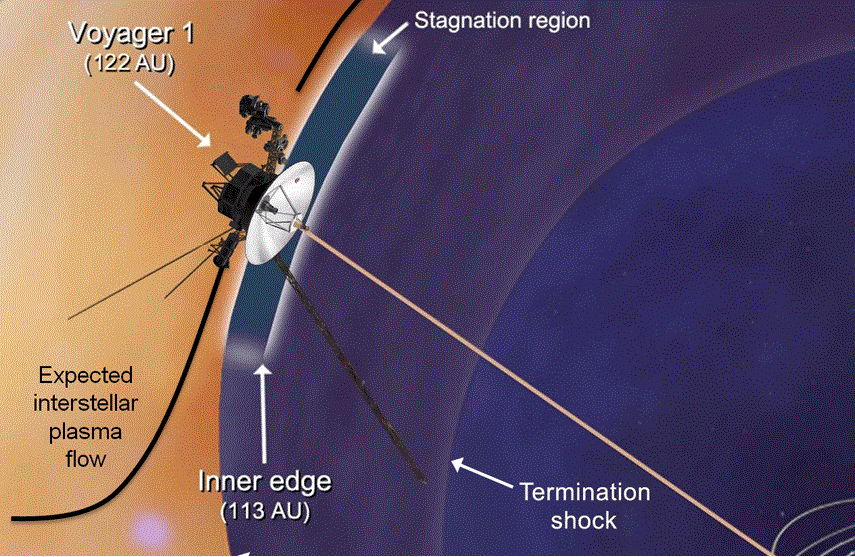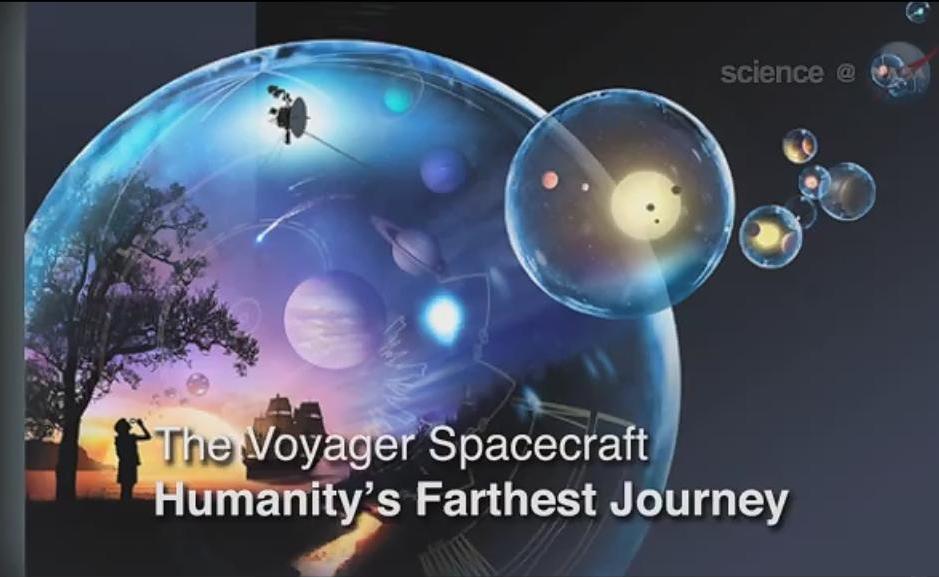It looks like you're using an Ad Blocker.
Please white-list or disable AboveTopSecret.com in your ad-blocking tool.
Thank you.
Some features of ATS will be disabled while you continue to use an ad-blocker.
share:
NASA has made a new discovery at the edge of space that allows charged particles from outside the galaxy in to the Solar System, in essence a
''Magnetic Highway''.
www.space.com...
www.redorbit.com...
www.nasa.gov...
NASA Animation
www.space.com...
NASA's Voyager 1 spacecraft has discovered a new layer of the solar system that scientists hadn't known was there, researchers announced today (Dec. 3).
Voyager 1 and its sister probe Voyager 2 have been traveling through space since 1977, and are close to becoming the first manmade objects to leave the solar system. Scientists haven't been sure exactly when that exit would occur, and now say the spacecraft are likely in the outermost region of the solar system, which is defined by the extent of the heliosphere, the large bubble of charged particles the sun puffs out around itself. Voyager 1, in particular, has entered a new region of the heliosphere that scientists are calling a "magnetic highway," which allows charged particles from inside the heliosphere to flow outward, and particles from the galaxy outside to come in.
"We do believe this may be the very last layer between us and interstellar space," Edward Stone, Voyager project scientist based at the California Institute of Technology, in Pasadena, Calif., said during a teleconference with reporters. "This region was not anticipated, was not predicted."
www.redorbit.com...
Data from the spacecraft revealed that the magnetic field became stronger every time Voyager entered the highway region, according to NASA.
www.nasa.gov...
Before Voyager 1 reached the magnetic highway, charged particles bounced around in all directions, as if trapped on local roads inside the heliosphere, as shown in the first scene. The pink particles are the lower-energy charged particles that originate from inside the heliosphere, which is the bubble of charged ions surrounding our sun. The second scene shows Voyager entering the highway region, where inside (pink) particles zip away and particles from interstellar space (blue) stream in. These interstellar particles are called cosmic ray particles and have more energy than the inside particles. In the third scene, further travel through the magnetic highway means that all of the inside particles are leaving and the population of outside particles is much higher. The cosmic ray particles rapidly fill this new region to the same level as outside and speed in all directions. The fourth scene shows the point at which all of the inside particles have zipped out, leaving an area dominated by cosmic rays from outside.
NASA Animation
edit on 3-12-2012 by theabsolutetruth because: (no reason given)
Many of us have been waiting for the Voyager probes to break the barrier into intersteller space, I look forward for definitive results that it has
entered this area.
Kind of mind blowing the concept of intersteller space and just the sheer vastness of it.
Kind of mind blowing the concept of intersteller space and just the sheer vastness of it.
reply to post by MDDoxs
It is very exciting, there are so many new things being discovered and this is pretty big, it wasn't predicted and it proves that there are things science is yet to discover of importance that could give way to new physics and understanding of the nature of the universe.
It is very exciting, there are so many new things being discovered and this is pretty big, it wasn't predicted and it proves that there are things science is yet to discover of importance that could give way to new physics and understanding of the nature of the universe.
reply to post by theabsolutetruth
very interesting news
here is the pic from your link,

we do live in a bubble
cool
star and flag
xploder
very interesting news
here is the pic from your link,

we do live in a bubble
cool
star and flag
xploder
Originally posted by theabsolutetruth
...it proves that there are things science is yet to discover of importance that could give way to new physics and understanding of the nature of the universe.
Thats what I was going to say
I'm absolutely fascinated by the voyagers, how long are they expected to keep transmitting data?
Originally posted by theabsolutetruth
reply to post by MDDoxs
It is very exciting, there are so many new things being discovered and this is pretty big, it wasn't predicted and it proves that there are things science is yet to discover of importance that could give way to new physics and understanding of the nature of the universe.
I've been keeping an eye on these two little guys as well. I wondered what the actual effect would be once they began crossing over.
With the forces of the sun behind them and the galactic forces headwind, I visual like a virtual 'dead calm' there that may take a decade to transcend.
There are l a lot of theories, some claims are vigorously touted,.. but until we actually get out there and do a taste test, everything else is presumptive science.
edit on 3-12-2012 by Lonewulph because: (no reason given)
reply to post by theabsolutetruth
It will definitely be interesting to keep track of the Voyager program over the next few months. Lots of interesting stuff going on in space exploration these days.
I bet we lose comm with the probes once they leave our solar system.
It will definitely be interesting to keep track of the Voyager program over the next few months. Lots of interesting stuff going on in space exploration these days.
I bet we lose comm with the probes once they leave our solar system.
Looking at the NASA animation, could these highways been used for a faster means of travel through space. I'm just throwIng that out there ...
Originally posted by VoidHawk
Originally posted by theabsolutetruth
...it proves that there are things science is yet to discover of importance that could give way to new physics and understanding of the nature of the universe.
Thats what I was going to say
I'm absolutely fascinated by the voyagers, how long are they expected to keep transmitting data?
Hopefully at least as long as expected...
www.space.com...
"We will have enough power for all the instruments until 2020; at that point we will have to turn off our first instrument," Stone said. By 2025 the last instrument will have to be turned off.
reply to post by JayinAR
I guess there will be a lot more energy when in the galaxy, though it would be awesome if transmission kept up at least for a while.
I guess there will be a lot more energy when in the galaxy, though it would be awesome if transmission kept up at least for a while.
reply to post by theabsolutetruth
here is my favourite voyager pic,

they really made good space probes in those days
xploder
here is my favourite voyager pic,

they really made good space probes in those days
xploder
reply to post by Lonewulph
I guess it would be awesome for even more exciting things to be found, truly the frontiers of modern science.
I guess it would be awesome for even more exciting things to be found, truly the frontiers of modern science.
Originally posted by theabsolutetruth
It is very exciting, there are so many new things being discovered and this is pretty big, it wasn't predicted and it proves that there are things science is yet to discover of importance that could give way to new physics and understanding of the nature of the universe.
It also shows that scientists are not afraid of showing their ignorance about things they are supposed to know.
I hope they find more unexpected things, those are my favourite.
reply to post by Philosophile
At the edge of the Solar System is the magnetic Heliosphere, a bubble created by the sun effectively. Voyager 1 has just got to the edge of this and has detected a new unpredicted area, where charged particles from the galaxy (outside of the Solar System) are entering the heliosphere. Essentially a ''Magnetic Highway'', the youtube Vid on the OP is a good visual reference, the first part is the heliosphere and the second part is Voyager 1 entering the ''Magnetic Highway''.
Here's the video again
At the edge of the Solar System is the magnetic Heliosphere, a bubble created by the sun effectively. Voyager 1 has just got to the edge of this and has detected a new unpredicted area, where charged particles from the galaxy (outside of the Solar System) are entering the heliosphere. Essentially a ''Magnetic Highway'', the youtube Vid on the OP is a good visual reference, the first part is the heliosphere and the second part is Voyager 1 entering the ''Magnetic Highway''.
Here's the video again
edit on 3-12-2012 by theabsolutetruth because: (no reason given)
new topics
top topics
-
January 6th report shows disturbing trend (nobody is shocked)
US Political Madness: 16 hours ago, 22 flags -
The Truth about Migrant Crime in Britain.
Social Issues and Civil Unrest: 17 hours ago, 12 flags -
Let's talk planes.
General Chit Chat: 14 hours ago, 5 flags -
Inexplicable military simulation - virtual reality showdown in the night..
The Gray Area: 16 hours ago, 2 flags
active topics
-
The Truth about Migrant Crime in Britain.
Social Issues and Civil Unrest • 14 • : Cymru -
Judge rules president-elect Donald Trump must be sentenced in 'hush money' trial
US Political Madness • 38 • : network dude -
January 6th report shows disturbing trend (nobody is shocked)
US Political Madness • 59 • : network dude -
Musk calls on King Charles III to dissolve Parliament over Oldham sex grooming gangs
Mainstream News • 198 • : Oldcarpy2 -
Greatest thing you ever got, or bought?
General Chit Chat • 23 • : DAVID64 -
ILLUMINATION: Dimensions / Degrees – Da Vincis Last Supper And The Philosophers Stone
Secret Societies • 12 • : Compendium -
Stuck Farmer And His Queue Jumping Spawn
Rant • 8 • : TimBurr -
Trudeau Resigns! Breaking
Mainstream News • 68 • : MindBodySpiritComplex -
Live updates: Congress meets to certify Trump's presidential election victory
US Political Madness • 19 • : KrustyKrab -
-@TH3WH17ERABB17- -Q- ---TIME TO SHOW THE WORLD--- -Part- --44--
Dissecting Disinformation • 3953 • : 777Vader
